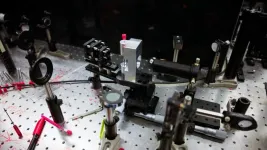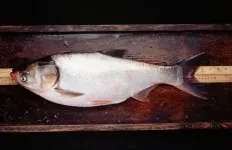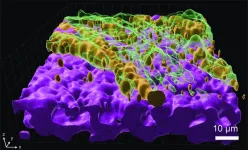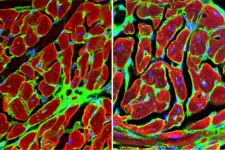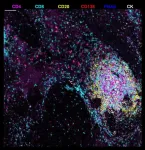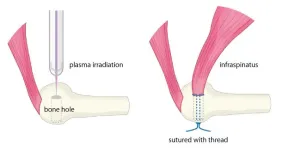(Press-News.org) Water is synonymous with life, but the dynamic, multifaceted interaction that brings H2O molecules together – the hydrogen bond – remains mysterious. Hydrogen bonds result when hydrogen and oxygen atoms between water molecules interact, sharing electronic charge in the process. This charge-sharing is a key feature of the three-dimensional ‘H-bond’ network that gives liquid water its unique properties, but quantum phenomena at the heart of such networks have thus far been understood only through theoretical simulations.
Now, researchers led by Sylvie Roke, head of the Laboratory for Fundamental BioPhotonics in EPFL’s School of Engineering, have published a new method – correlated vibrational spectroscopy (CVS) – that enables them to measure how water molecules behave when they participate in H-bond networks. Crucially, CVS allows scientists to distinguish between such participating (interacting) molecules, and randomly distributed, non-H-bonded (non-interacting) molecules. By contrast, any other method reports measurements on both molecule types simultaneously, making it impossible to distinguish between them.
“Current spectroscopy methods measure the scattering of laser light caused by the vibrations of all molecules in a system, so you have to guess or assume that what you are seeing is due to the molecular interaction you’re interested in,” Roke explains. “With CVS, the vibrational mode of each different type of molecule has its own vibrational spectrum. And because each spectrum has a unique peak corresponding to water molecules moving back and forth along the H-bonds, we can measure directly their properties, such as how much electronic charge is shared, and how H-bond strength is impacted.”
The method, which the team says has “transformative” potential to characterize interactions in any material, has been published in Science.
Looking at things from a new angle
To distinguish between interacting and non-interacting molecules, the scientists illuminated liquid water with femtosecond (one quadrillionth of a second) laser pulses in the near-infrared spectrum. These ultra-short bursts of light create tiny charge oscillations and atomic displacements in the water, which trigger the emission of visible light. This emitted light appears in a scattering pattern that contains key information about the spatial organization of the molecules, while the color of the photons contains information about atomic displacements within and between molecules.
“Typical experiments place the spectrographic detector at a 90-degree angle to the incoming laser beam, but we realized that we could probe interacting molecules simply by changing the detector position, and recording spectra using certain combinations of polarized light. In this way, we can create separate spectra for non-interacting and interacting molecules,” Roke says.
The team conducted more experiments aimed at using CVS to tease apart the electronic and nuclear quantum effects of H-bond networks, for example by changing the pH of water through the addition of hydroxide ions (making it more basic), or protons (more acidic).
“Hydroxide ions and protons participate in H-bonding, so changing the pH of water changes its reactivity,” says PhD student Mischa Flór, the paper’s first author. “With CVS, we can now quantify exactly how much extra charge hydroxide ions donate to H-bond networks (8%), and how much charge protons accept from it (4%) – precise measurements that could never have been done experimentally before.” These values were explained with the aid of advanced simulations conducted by collaborators in France, Italy, and the UK.
The researchers emphasize that the method, which they also corroborated via theoretical calculations, can be applied to any material, and indeed several new characterization experiments are already underway.
“The ability to quantify directly H-bonding strength is a powerful method that can be used to clarify molecular-level details of any solution, for example containing electrolytes, sugars, amino acids, DNA, or proteins,” Roke says. “As CVS is not limited to water, it can also deliver a wealth of information on other liquids, systems, and processes.”
END
A new spectroscopy reveals water’s quantum secrets
For the first time, EPFL researchers have exclusively observed molecules participating in hydrogen bonds in liquid water, measuring electronic and nuclear quantum effects that were previously accessible only via theoretical simulations
2024-10-25
ELSE PRESS RELEASES FROM THIS DATE:
Sliver of cool surface water helps the ocean absorb more carbon
2024-10-25
Subtle temperature differences at the ocean surface allow more carbon dioxide (CO₂) to be absorbed, new research shows.
Scientists studied the “ocean skin” – a sliver less than 2 mm deep at the ocean surface that is fractionally cooler than the rest.
Theoretical and lab work have suggested this temperature difference should increase the amount of CO₂ absorbed by the ocean – but this had never been successfully observed at sea before.
The new study – led by researchers from the University of Exeter’s Penryn Campus in Cornwall – used precision measurements to confirm that the ...
Study: Invasive silver carp reduce movement in Chicago-area water
2024-10-25
URBANA, Ill. — Invasive silver carp have been spreading throughout the Mississippi River Basin since their introduction a half-century ago. Yet, try as they might, the fish have not advanced beyond a particular stretch of the Illinois River north of Kankakee. Research from the University of Illinois Urbana-Champaign shows the fish are likely avoiding contaminants from the Chicago Area Waterway, which flows south before petering out around Kankakee.
A new study, published today in Scientific Reports, shows silver carp change their behavior and metabolism when introduced to water from the Illinois River north of Kankakee, representing Chicago-area water.
“When animals ...
A lung pathogen’s dilemma: infect or resist antibiotics?
2024-10-25
Imagine trying to settle into a new home while constantly being attacked. That’s what the bacterium Pseudomonas aeruginosa faces when it infects the lungs, and it can’t both spread and protect itself from antibiotics at the same time. Nonetheless, it’s one of the top culprits in hospital-acquired infections and it’s notorious for causing long-lasting, antibiotic-resistant infections, causing damage especially in people with lung diseases like cystic fibrosis, COPD, or bronchiectasis.
To survive tough conditions, P. aeruginosa forms colonies ...
Batteries for miniature bio-integrated devices and robotics — here’s how to do it
2024-10-25
University of Oxford researchers have made a significant step towards realising miniature, soft batteries for use in a variety of biomedical applications, including the defibrillation and pacing of heart tissues. The work has been published today in the journal Nature Chemical Engineering.
The development of tiny smart devices, smaller than a few cubic millimeters, demands equally small power sources. For minimally invasive biomedical devices that interact with biological tissues, these power sources must be fabricated from soft materials. Ideally, these should ...
UCLA researchers uncover novel role of protein GPNMB in heart repair
2024-10-25
FINDINGS
UCLA scientists have identified the protein GPNMB as a critical regulator in the heart’s healing process after a heart attack.
Using animal models, they demonstrate that bone marrow-derived immune cells called macrophages secrete GPNMB, which binds to the receptor GPR39, promoting heart repair. These findings offer a new understanding of how the heart heals itself and could lead to new treatments aimed at improving heart function and preventing the progression to heart failure.
BACKGROUND
Every 40 seconds, ...
Political polarization poses health risks, new analysis concludes
2024-10-25
News coverage of the 2024 election season has often centered on how partisan division has affected our politics. But a new analysis shows that political polarization also poses significant health risks—by obstructing the implementation of legislation and policies aimed at keeping Americans healthy, by discouraging individual action to address health needs, such as getting a flu shot, and by boosting the spread of misinformation that can reduce trust in health professionals.
“Compared to other high-income countries, the United States has a disadvantage when it comes to the health of its citizens,” ...
Lymph node-like structures may trigger the demise of cancer tumors
2024-10-25
**EMBARGOED FOR RELEASE UNTIL OCT. 25 AT 5 A.M. ET**
A newly described stage of a lymph node-like structure seen in liver tumors after presurgical immunotherapy may be vital to successfully treating patients with hepatocellular carcinoma, according to a study by researchers from the Johns Hopkins Kimmel Cancer Center.
The study, published Oct. 25 in Nature Immunology, provides new information about lymph node-like structures called tertiary lymphoid structures. These structures, which are highly organized ...
Pitchers rejoice? Plasma irradiation might prevent tendon re-tears
2024-10-25
The human body, filled with muscles and moving parts, is far from indestructible. Injuries are common, especially where tendons and bones connect. In Japan, rotator cuff tears affect approximately 1 in 4 people over age 50, and reports state that even after surgery, about 20% of cases result in re-tears. To combat this, new healing methods to bolster current clinical practices are needed.
Graduate student Katsumasa Nakazawa, Associate Professor Hiromitsu Toyoda, and then Professor Hiroaki Nakamura at Osaka Metropolitan University’s ...
The clinical significance of microvascular inflammation after kidney transplantation
2024-10-25
San Diego, CA (October 24, 2024) — Investigators recently uncovered key insights into newly defined rejection entities in kidney transplantation that may offer improved patient risk categorization post-transplant. The research will be presented at ASN Kidney Week 2024 October 23– 27.
Kidney transplant rejection continues to threaten the long-term success of kidney transplants, with microvascular inflammation (inflammation within capillaries) playing a pivotal role in graft failure. Due to its complex nature, this inflammation poses a major challenge in clinical practice. In response, the international Banff classification—the ...
The Lancet Public Health: New Commission calls for regulatory reform to tackle the health impacts of the rapid global expansion of commercial gambling
2024-10-24
**Embargo: 23.30 [UK time] / 06.30pm [US ET] Thursday 24th October 2024**
Peer reviewed / Literature review, systematic review and meta-analysis, opinion / People
Embargoed access to the Commission report and contact details for authors are available in Notes to Editors at the end of the release.
The Lancet Public Health: New Commission calls for regulatory reform to tackle the health impacts of the rapid global expansion of commercial gambling
Gambling harms are far more substantial than previously understood, exacerbated by rapid global expansion ...
LAST 30 PRESS RELEASES:
Common brain parasite can infect your immune cells. Here's why that's probably OK
International experts connect infections and aging through cellular senescence
An AI–DFT integrated framework accelerates materials discovery and design
Twist to reshape, shift to transform: Bilayer structure enables multifunctional imaging
CUNY Graduate Center and its academic partners awarded more than $1M by Google.org to advance statewide AI education through the Empire AI consortium
Mount Sinai Health system receives $8.5 million NIH grant renewal to advance research on long-term outcomes in children with congenital heart disease
Researchers develop treatment for advanced prostate cancer that could eliminate severe side effects
Keck Medicine of USC names Christian Pass chief financial officer
Inflatable fabric robotic arm picks apples
MD Anderson and SOPHiA GENETICS announce strategic collaboration to accelerate AI-driven precision oncology
Oil residues can travel over 5,000 miles on ocean debris, study finds
Korea University researchers discover that cholesterol-lowering drug can overcome chemotherapy resistance in triple-negative breast cancer
Ushikuvirus: A newly discovered giant virus may offer clues to the origin of life
Boosting the cell’s own cleanup
Movement matters: Light activity led to better survival in diabetes, heart, kidney disease
Method developed to identify best treatment combinations for glioblastoma based on unique cellular targets
Self-guided behavioral app helps children with epilepsy sleep earlier
Higher consumption of food preservatives is associated with an increased risk of type 2 diabetes
NTU Singapore-led team captures first-ever ‘twitch’ of the eye’s night-vision cells as they detect light, paving the way for earlier detection of blindness-causing diseases
Global aviation emissions could be halved through maximising efficiency gains, new study shows
Fewer layovers, better-connected airports, more firm growth
Exposure to natural light improves metabolic health
As we age, immune cells protect the spinal cord
New expert guidance urges caution before surgery for patients with treatment-resistant constipation
Solar hydrogen can now be produced efficiently without the scarce metal platinum
Sleeping in on weekends may help boost teens’ mental health
Study: Teens use cellphones for an hour a day at school
After more than two years of war, Palestinian children are hungry, denied education and “like the living dead”
The untold story of life with Prader-Willi syndrome - according to the siblings who live it
How the parasite that ‘gave up sex’ found more hosts – and why its victory won’t last
[Press-News.org] A new spectroscopy reveals water’s quantum secretsFor the first time, EPFL researchers have exclusively observed molecules participating in hydrogen bonds in liquid water, measuring electronic and nuclear quantum effects that were previously accessible only via theoretical simulations
